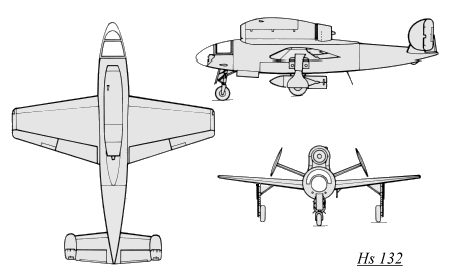 The RLM (Reichsluftfahrt-Ministerium) issued
a specification for a single-seat shipping attack aircraft on February
18, 1943, to combat the anticipated invasion of Europe. Although the specification
called for a piston-engined powered aircraft, but it was soon realized
that only a turbojet could hope to match the proposed performance requirements.
Henschel submitted a design for RLM approval in April/May 1944 (wind tunnel
testing had already started, see wind tunnel model below), which was approved
as the Hs 132. The fuselage was of a circular cross-section, and
constructed entirely of metal, and the single BMW 003 jet engine was mounted
on the fuselage top. The mid-fuselage mounted wings were mostly of wooden
construction, and had a slight taper on the leading and trailing edges.
Due to the position of the engine, a twin fin and rudder configuration
was chosen, to allow the jet to exhaust without interfering with the tail
unit. A tricycle landing gear was to be used, with the nose wheel revolving
90 degrees to lie under the cockpit when retracted; the main gear retracted
inwards. The extensively glazed cockpit was completely faired in with the
rest of the fuselage, and the pilot was in a prone position, the better
to withstand the intense G-forces of the fast, steep dive during the bomb
run. The pilot's controls featured a spring-operated power rudder, since
a pilot in the prone position could exert less pressure on the rudder controls.
The RLM (Reichsluftfahrt-Ministerium) issued
a specification for a single-seat shipping attack aircraft on February
18, 1943, to combat the anticipated invasion of Europe. Although the specification
called for a piston-engined powered aircraft, but it was soon realized
that only a turbojet could hope to match the proposed performance requirements.
Henschel submitted a design for RLM approval in April/May 1944 (wind tunnel
testing had already started, see wind tunnel model below), which was approved
as the Hs 132. The fuselage was of a circular cross-section, and
constructed entirely of metal, and the single BMW 003 jet engine was mounted
on the fuselage top. The mid-fuselage mounted wings were mostly of wooden
construction, and had a slight taper on the leading and trailing edges.
Due to the position of the engine, a twin fin and rudder configuration
was chosen, to allow the jet to exhaust without interfering with the tail
unit. A tricycle landing gear was to be used, with the nose wheel revolving
90 degrees to lie under the cockpit when retracted; the main gear retracted
inwards. The extensively glazed cockpit was completely faired in with the
rest of the fuselage, and the pilot was in a prone position, the better
to withstand the intense G-forces of the fast, steep dive during the bomb
run. The pilot's controls featured a spring-operated power rudder, since
a pilot in the prone position could exert less pressure on the rudder controls.
![]() Andreas Otte's Hs 132 images
Andreas Otte's Hs 132 images ![]() Mario Merino's Hs 132 images
Mario Merino's Hs 132 images
Span: 7.85 m (25' 9") Length: 8.8 m (28' 10.5") Max. Speed: 780 km/h (484 mph)
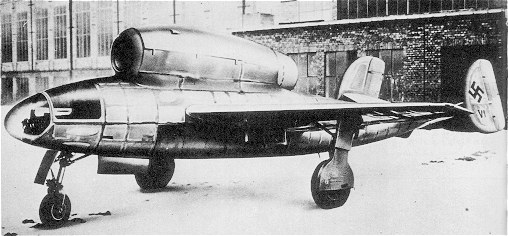
Although some references refer to this picture
as a photo of the completed Hs 132 V1, it is actually an artist's impression
by Gert Heumann....
|
The Hs 132 V1 airframe, including the BMW 003 jet engine
|
A close-up of the cockpit
area....
note the armored glass windshield 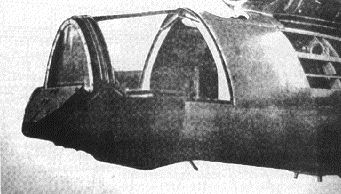 |
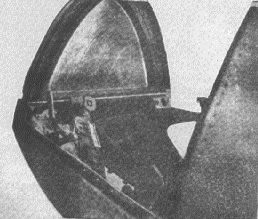
Another view of the cockpit, including the two control sticks and instrumentation |
|
The original Hs 132 wind tunnel model....
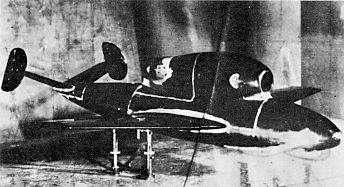 |